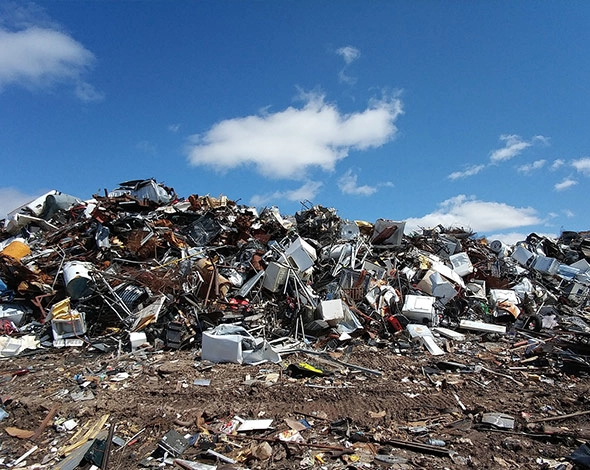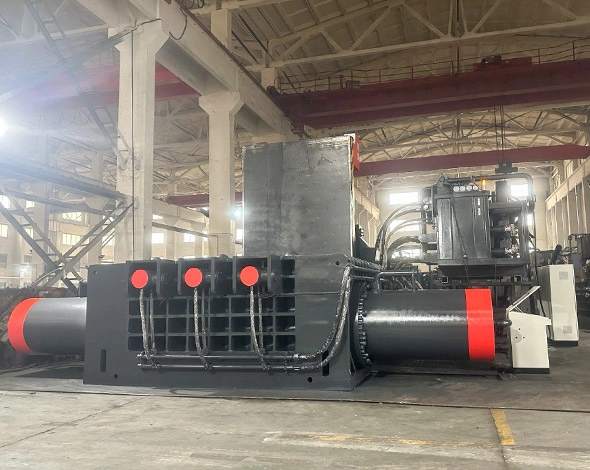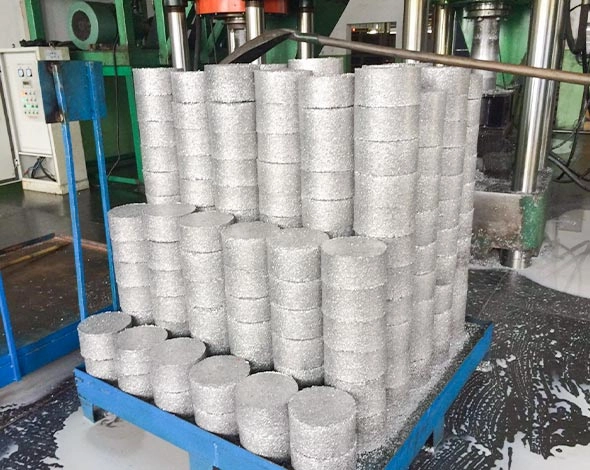Scrap metal recycling is a critical component of modern waste management practices, playing a vital role in conserving resources, reducing greenhouse gas emissions, and minimizing landfill use.
Among the various technologies that enhance the efficiency of this process, metal balers are particularly pivotal. These machines compact assorted scrap metals into dense, manageable bundles, making transportation and further processing more cost-effective and environmentally friendly.
This article will explore metal balers’ fundamental operations and substantial impact on the recycling industry.
How do Hydraulic Metal Balers Work?
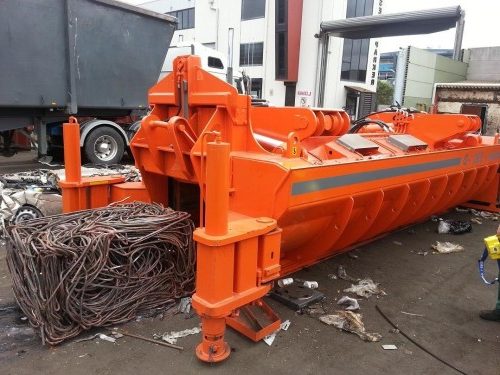
Hydraulic metal balers are the primary choice in the recycling industry, prized for their powerful performance and efficiency. They utilize a hydraulic pressure system that uses oil to power pistons, which compress the scrap metal.
Operation Process
- Loading the Chamber: Scrap metal is manually placed into the feeding chamber using mechanical equipment.
- Compression Cycle:
- Closure: The operator closes the chamber once it is complete.
- Compression: Hydraulic pistons push the metal against a fixed wall, significantly reducing its volume.
After Compression
- Binding: The compressed metal is then bound with wires or straps.
- Transportation: This ensures the metal remains in compact bale form, simplifying storage and transportation.
Applications of Metal Balers in Scrap Metal Recycling
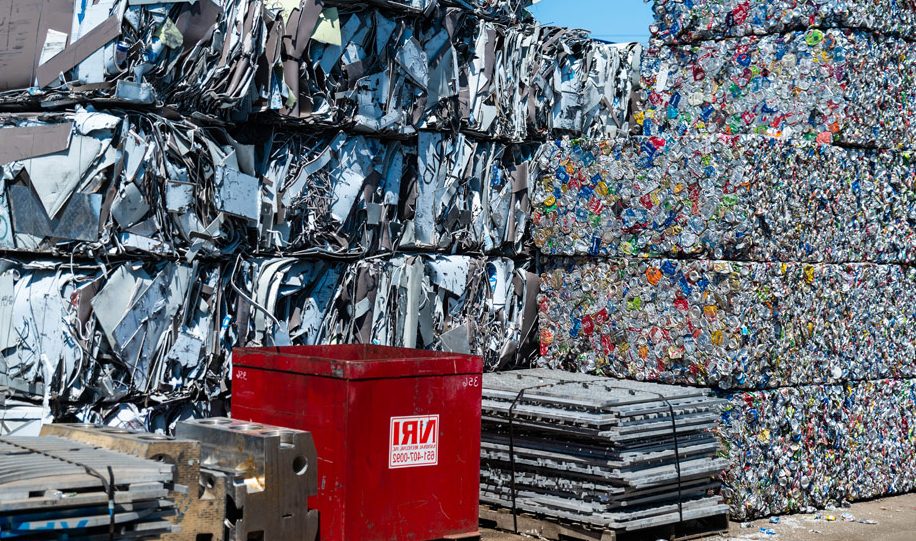
Metal balers are crucial in scrap metal recycling, enhancing operational efficiency and economic viability. Here’s a detailed breakdown of their applications:
Types of Metals Handled
- Ferrous Metals: Includes iron and steel. Balers compress these into large, dense bales, which are highly valued in the market.
- Non-ferrous Metals: Such as aluminum, copper, and brass. These are lighter and often require different baler settings to ensure optimal compression.
Streamlining Recycling Operations
- Volume Reduction: Balers reduce the volume of metal waste, which decreases storage space requirements and lowers transportation costs.
- Improved Handling: Baled metals are easier to handle and transport, facilitating a more efficient recycling process.
- Enhanced Sorting: Compressed and baled metals are more uncomplicated to sort according to type and quality, improving the efficiency of the recycling process.
Economic Impact
- Cost Efficiency: Balers significantly cut logistics and storage expenses by reducing volume and improving handling.
- Market Value: Baled scrap metals often fetch higher prices due to their uniformity and ease of processing by recyclers.
Environmental Benefits
- Resource Conservation: Compacting scrap metal reduces the need for new metal production, conserving natural resources and energy.
- Reduced Carbon Footprint: Fewer transportation trips mean lower emissions, reducing the recycling operation’s carbon footprint.
Economic Benefits of Using Metal Balers
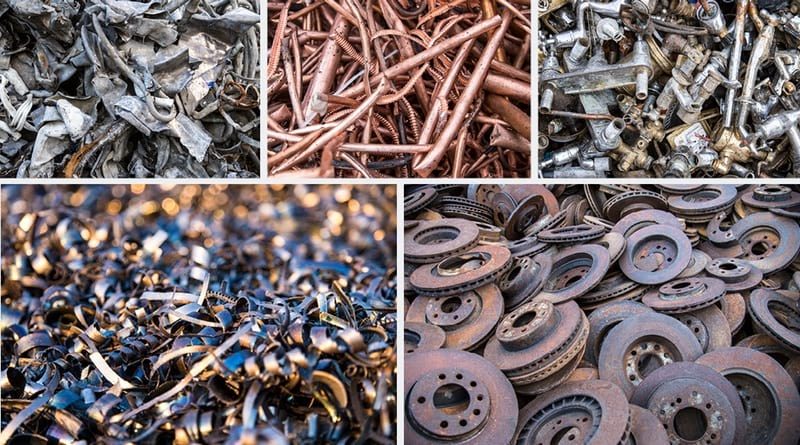
Using metal balers in scrap metal recycling operations brings several significant economic benefits. These benefits not only streamline the recycling process but also enhance the profitability of the operations. Here’s a detailed look at the economic advantages:
Cost Reduction in Transportation and Storage
-
- Reduced Volume: Metal balers compress scrap into smaller, more uniform bales, significantly reducing the volume of scrap metal. This reduction allows more material to be transported in one trip, lowering transportation costs.
- Optimized Storage: Baled scrap takes up less space, which optimizes warehouse or yard storage and reduces storage costs.
Increased Efficiency
-
- Faster Processing: Balers speed up scrap metal processing by quickly converting loose scrap into manageable bales. This efficiency reduces labor costs and speeds up the overall recycling workflow.
- Reduced Handling Costs: Compact bales are more manageable and less costly to handle and move around, which decreases the need for extensive labor and machinery.
Improved Market Value
-
- Enhanced Scrap Quality: Baled scrap is generally cleaner and more sorted, increasing its quality and market value. Recyclers are willing to pay more for baled scrap because it requires less processing before it can be reused or melted down.
- Consistent Product for Buyers: Baled metal provides a more consistent product for buyers, making it easier to process and use in manufacturing. This consistency can lead to better customer relationships and potentially higher prices.
Scalability
-
- Adaptable to Growth: As recycling operations grow, metal balers can be scaled to meet increased demand without additional costs. This adaptability allows businesses to expand their operations efficiently.
Waste Minimization
-
- Reduced Waste: Less material is discarded as waste by efficiently compressing and baling scrap. This efficiency can lead to cost savings in waste management and disposal.
These economic benefits make metal balers an indispensable tool in the recycling industry, enhancing recycling businesses’ operational efficiency and profitability.
Environmental Impact
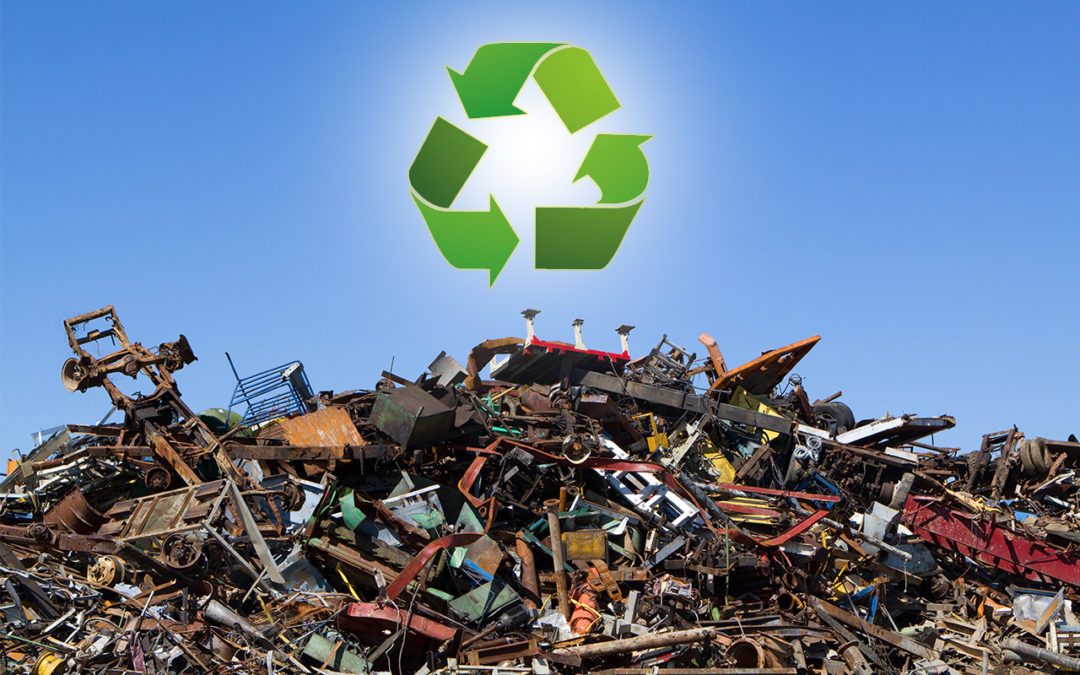
Metal balers significantly contribute to environmental sustainability in the scrap metal recycling industry. Here’s how their use impacts the environment positively:
Reduction in Landfill Waste
- Volume Reduction: By compressing scrap metal into compact bales, metal balers reduce the overall volume of waste. This efficiency minimizes the amount of scrap metal in landfills, thereby conserving landfill space.
- Improved Recycling Rates: Compact bales are more accessible to process and recycle, leading to higher recycling rates and less waste generation.
Conservation of Natural Resources
- Reduced Demand for Raw Materials: Recycling metal using balers decreases the need for virgin metal extraction. By recycling old metal, the industry reduces the demand for new raw materials, conserving natural resources such as iron ore, bauxite, and other metals.
- Energy Savings: Producing new metal from recycled materials consumes significantly less energy than extracting and processing raw materials. Metal balers help ensure that more metal is recycled, thus saving energy.
Reduction in Greenhouse Gas Emissions
- Efficient Transportation: Compressed and baled metals are more transport-efficient, allowing more material to be moved per trip. This efficiency reduces the number of transport trips needed, decreasing fuel consumption and associated greenhouse gas emissions.
- Lower Energy Consumption in Production: Since recycling metals requires less energy than producing new metals from ore, the overall energy consumption in metal production is reduced, leading to lower carbon dioxide emissions and other greenhouse gases.
Enhanced Ecosystem Protection
- Less Mining Impact: Reducing the need for mining through effective recycling protects ecosystems affected by mining operations. Mining activities often lead to deforestation, soil erosion, and habitat destruction. By using recycled metals, the pressure on these natural environments is alleviated.
- Reduction in Water Pollution: Mining and refining processes can lead to water pollution through runoff and toxic materials leaching. Recycling scrap metal using balers minimizes these impacts by decreasing the demand for mined resources.
The environmental benefits of using metal balers are substantial, contributing to a more sustainable and responsible metal recycling industry. These benefits align with global efforts to combat climate change, conserve natural resources, and protect ecosystems, making metal balers a critical component of the green economy.
Technological Advancements in Metal Balers
Technological advancements in metal balers have significantly enhanced their efficiency and effectiveness, allowing the scrap metal recycling industry to improve operational capabilities and environmental sustainability.
Here are some key innovations in the technology of metal balers:
Automation and Control Systems
- Intelligent Operation: Modern metal balers have advanced control systems that automate many processes of baling scrap metal. These systems can adjust parameters like pressure and timing based on the type of metal being processed, optimizing efficiency and reducing manual labor.
- Remote Monitoring: Many balers now come with IoT (Internet of Things) capabilities, allowing operators to monitor and control the machines remotely. This feature helps manage operations more efficiently and quickly addresses issues, minimizing downtime.
Improved Hydraulic Systems
- Energy Efficiency: Newer models of hydraulic metal balers use energy more efficiently, thanks to hydraulic fluid dynamics and piston design improvements. These enhancements reduce the overall energy consumption of the machines while maintaining or even increasing their output capacity.
- Faster Cycle Times: Advanced hydraulic systems provide quicker compression cycles, which increases the throughput of scrap metal processing. This speed-up in operation allows recycling facilities to handle larger volumes of scrap more quickly.
Material Handling Innovations
- Pre-Compression Technology: Some balers now incorporate pre-compression technology that prepares the scrap before it enters the main compression chamber. This step ensures more uniform bales and helps achieve higher density, crucial for reducing transportation and storage costs.
- Versatility in Processing: Technological advancements have also led to balers that can handle a broader range of materials, from lightweight aluminum to heavy steel. This versatility allows recycling facilities to use a single machine for various types of scrap, simplifying operations and reducing equipment costs.
Safety and Reliability
- Enhanced Safety Features: Modern balers include better safety mechanisms to protect operators, such as emergency stops, automatic shutdowns when anomalies are detected, and protective guarding around moving parts.
- Durability and Maintenance: Technological improvements have also focused on making balers more durable and easier to maintain. Using better materials and more accessible designs for regular maintenance tasks helps extend the lifespan of the equipment and ensures it runs smoothly.
Integration with Recycling Systems
- Data Analytics: Some advanced balers are equipped with data analytics capabilities, collecting and analyzing data on throughput, material types, and operational efficiency. This information can be used to optimize the recycling process further and improve the operation’s overall profitability.
| Feature | Old Model | New Model | Improvement |
|---|---|---|---|
| Hydraulic Efficiency | Low | High | Enhanced fluid dynamics and better piston design |
| Energy Consumption | High | Low | More efficient use of energy |
| Cycle Time | Slow | Fast | Faster compression cycles |
| Safety Features | Basic | Advanced | Emergency stops, automatic shutdowns |
| Automation | Manual | Automated | Innovative operation systems, remote monitoring |
| Material Handling | Limited | Versatile | Can handle a broader range of materials |
These technological advancements improve the operational aspects of metal balers and contribute significantly to making the recycling process more sustainable, cost-effective, and adaptable to changing industry needs.
Conclusion
Metal balers are crucial for enhancing the efficiency and sustainability of the scrap metal recycling industry. Compacting scrap into bales reduces costs and improves handling, making recycling processes more economical and environmentally friendly.
Ongoing technological advancements continue to optimize their performance and adaptability, ensuring that metal balers remain essential tools in the recycling sector.

